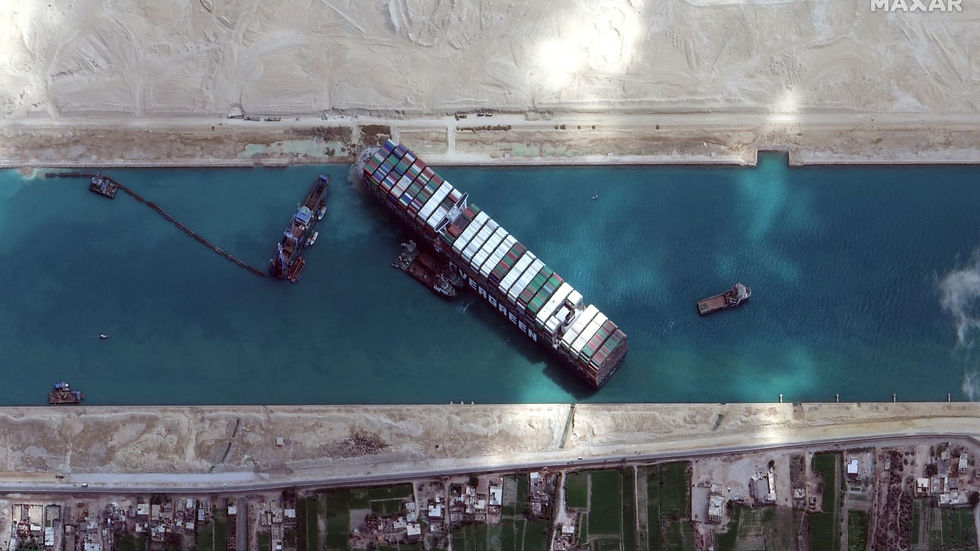Choked - Suez Canal Crisis
- Aftar Ahmed

- Mar 30, 2021
- 5 min read

Image Credits: CNBC
Imagine an aircraft carrier blocks the strait of malacca from where the majority of Asia-Pacific trade supply lines go through. What we would be seeing in the next 10 days would be supply curtailment, critical products being hoarded, maybe even price rise and in the era of the pandemic we may see a nationalistic race to get hands over the supplies as fast as one can. In total, we are imagining a situation of total chaos and upheaval for international trade security. Well, this was a military situation but what if this same situation is created by a container ship for no strategic or wartime reason. The current blockage of the Suez Canal is an alarm bell for all the international players, countries and companies involved in global trade that our supply chains are not only vulnerable to military or nationalistic competition, one nation dependence but also by the excess of globalisation. The Suez Canal blockage shows how small choke points on the globe can affect global trade and services. This crisis also shows that our infrastructure is lacking and is behind the pace of globalisation. But before examining the burden of rapid and competitive globalisation on our infrastructure and vulnerability caused by chokepoints, let us get familiar with the Suez Canal.
Canal that Connects
Suez Canal was built in 1869. This canal directly links the Mediterranian sea and the Red sea. which basically means that this canal is the spinal cord of the Asia-Europe supply trade route and is geopolitically strategic. It is one of the world’s heavily used shipping lanes, it carries 12% of global trade by volume. In 2020, around 19000 ships with a net tonnage of 1.17 billion passed through the canal. The point to be noted here is that this was the pandemic year and still trade was in huge numbers. This number shows the importance of the canal. This canal is a great source of income for the African nation - Egypt, which nationalised it in 1956. This canal has proved to be a crucial link between the west and the east for natural gas, oil and cargo trade. The current infrastructure of the Suez Canal can let 50 ships pass through it in a day. The permissible length of a container ship in the canal is 1300 feet that is the exact length of one of the world’s largest container ships “Ever given” that got stuck and blocked the canal.
Infrastructure Paralysis
From 2015 to 2021, the infrastructure and capacity of the canal have been almost the same. The only big change was the opening up of a parallel channel. but the number of ships and containers crossing has increased from 17000 to 19000. This shows that the infrastructure is under immense burden from rapid globalisation. Adding to this is the demand and competition to deliver faster. Which has led to malpractices and corruption to pass the ship or to let the containers pass which sometimes doesn’t fulfil the requirements or is carrying extra load. This has led to the infrastructure paralysis in key global ship lanes like the Suez Canal. Another example is the Panama Canal even after its increased capacity in 2015. The canal is facing issues, a recent incident in December 2020, when the canal was overburdened by the traffic of ships. This led to delays and jams in the canal. Adding to this is the droughts in surrounding areas which has led to lower water levels in the canal leading to authorities placing restrictions on transits through the canal. So yes, globalisation has to worry about the climate crisis. One created by itself. This paralysis shows that the increasing speed of globalisation is tough to catch up and this requires a concentrated effort. Passages like these are not only essential for economies but also for the basic existence of societies and their markets.
Chokepoints
The Suez Canal crisis shows us how a blockage can cause a standstill condition for global trade as the alternatives to this canal are both economically and geographically not viable to pursue. Trade between Asia and Europe takes place in billions of dollars, so the stakes are high in a crisis like this one. The current blockage led to $6-10 billion loss in a week. The alternative to the Suez Canal right now is transit from the Cape of Good Hope, South Africa all the way to Europe which takes an additional 15 days or 3000 nautical miles. While cheap oil rates have made it somewhat feasible but the delivery time still discourages and excessive competition has also made this alternative a downgrade option. Pirate problem is also a big problem to pursue this alternative. The tradelines around the African continent remain volatile.
The crisis of blockage in the Suez Canal has not only delayed the trade but has also caused a traffic jam on the oceans and has burdened Port Tewfik which is also called the entrance point to the canal. Now that Ever Given is afloat it will take 3.5 days to clear the traffic jam and resume the normal workings of the port and the canal. This blockage has shown many of our global trade structure's vulnerabilities from the excessive burden on the infrastructure, stopping of critical supply chain trade in the height of global supply season and show us how the entire market based liberal economic structure can be affected by one ship blocking a canal. The Suez Canal is a chokepoint and with very less feasible alternatives to this chokepoint, we need to look into the possible way outs and be prepared for future crises. Chokes and standstills during a pandemic to the vital trade routes can prove to be detrimental, as critical supply chains need to be delivered on time. One thing Suez Canal blockage has shown us is that Chokes can be caused by normal trade routine too.
Way Out - Unchoke
This new decade has shown us our major vulnerabilities from the medical system to our infrastructure. Lessons have to be learnt and new methods have to be practised to avoid chaos and chokes in future. The way out now remains increasing infrastructure capacity both in size and greener outlook way ahead of time. Egypt has a plan to increase the capacity of the port and canal, but the project is way ahead of its time. The goal is not to increase the capacity only but catch up and stay ahead of the excessive pace of globalisation. Another important thing is to make the institutions governing and managing these vital routes - responsible and accountable. Corruption and malpractices in places like the Suez Canal Authority have to be curbed and looked after. We also need to place an international review of critical trade routes annually by international authorities to examine them and look at the shortcomings. On the other hand, we need to look into excessive globalisation and we need to need device strategies to keep global supply lanes afloat and intact. Viable alternatives need to be created so in time of emergency we have structures to fall back on and keep moving.
By Harsh Suri
kuku.harsh@gmail.com
Harsh is on his mission with political science as his partner. Hindu College has given him a lot of know-how too. He is driven by geopolitics and geo-strategic issues. he loves to blend and understand international affairs with the domestic characteristics that shape it. Harsh believes in digging down the topic rather than having a cakewalk on it. you can ping him up on foreign policy anytime.






Comments